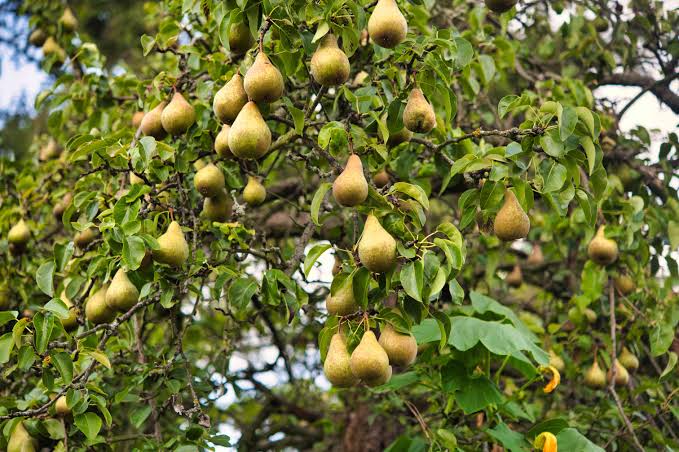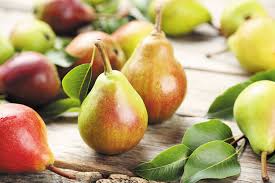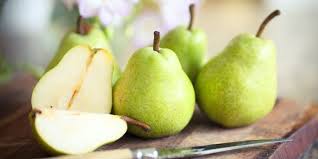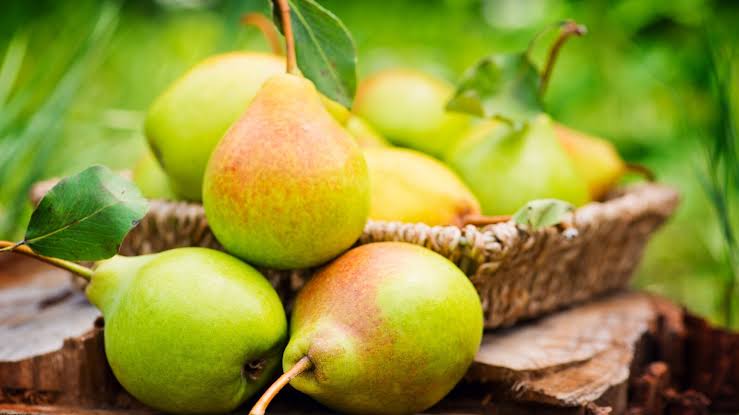A pear is a tasty and juicy fruit that comes in various shapes and sizes. This delightful fruit belongs to the Rosaceae family, just like apples and cherries. Pears are known for their sweet and slightly grainy texture, making them a popular choice for snacking, desserts, and even in salads.
One remarkable aspect of pears is their diverse range of colors, including green, red, and yellow varieties. Each hue has its own unique flavor, adding to the excitement of enjoying this delectable fruit. Pears can be enjoyed fresh, but they are also used in cooking and baking to create mouthwatering dishes.
When you bite into a ripe pear, you experience a burst of sweetness that is both satisfying and refreshing. The natural sugars in pears make them a delightful treat for those with a sweet tooth, while their high water content ensures a juicy and hydrating experience.
Pears are not only delicious but also pack a nutritional punch. They are a good source of dietary fiber, which promotes digestive health and helps maintain a feeling of fullness. Additionally, pears contain essential vitamins and minerals, contributing to overall well-being.
One interesting fact about pears is that they continue to ripen after being picked. This unique characteristic allows you to control the level of ripeness based on your preference. Whether you prefer a crisp and crunchy pear or a softer, more tender one, the choice is yours.
Cultivated in various parts of the world, pears have become a staple in many cuisines. From the crisp Bosc pear to the sweet and juicy Bartlett pear, each variety offers a distinct flavor profile, catering to different taste preferences.
Pears are not just for eating on their own; they also play a starring role in culinary creations. Poached pears drizzled with honey, pear tarts, and pear-infused salads are just a few examples of the delightful dishes that showcase the versatility of this fruit.
In addition to their culinary uses, pears have found their way into folklore and literature. Symbolizing various themes such as prosperity, longevity, and wisdom, the pear holds cultural significance in different societies around the world.
The pear is a wonderful fruit that captivates our taste buds with its sweetness, offers nutritional benefits, and adds a touch of elegance to a variety of dishes. Whether enjoyed fresh, cooked, or as part of a creative recipe, the pear remains a timeless and beloved fruit for people of all ages to savor.
Read Also: Pig Behaviour and the Effect of Climate
How to Grow and Care for Pea

Growing pears can be a rewarding experience, whether you have a spacious garden or a small backyard. Here’s a simple guide to help you cultivate and care for pear trees:
1. Planting: Choose a sunny location with well-draining soil for planting pear trees. Pears thrive in full sunlight, which helps in their overall growth and fruit development. Ensure proper spacing between pear trees to allow for good air circulation, which can help prevent diseases. Plant the pear tree during the dormant season, typically in late winter or early spring. This allows the tree to establish its roots before the growing season.
2. Soil and Watering: Pears prefer slightly acidic to neutral soil. Conduct a soil test to determine if any amendments are needed to achieve the right pH level. Provide consistent watering, especially during dry spells. Adequate moisture is crucial, especially during the growing season and when the fruit is developing. However, avoid waterlogged soil.
3. Fertilization: Fertilize pear trees in early spring before the growing season begins. Use a balanced fertilizer or one specifically formulated for fruit trees. Avoid excessive nitrogen, as it can lead to excessive foliage growth at the expense of fruit production.
4. Pruning: Regular pruning is essential for pear trees to promote proper shape, air circulation, and sunlight exposure. Prune during the dormant season to avoid stress to the tree. Remove any dead, damaged, or diseased branches to maintain tree health.
5. Disease and Pest Control: Keep an eye out for common pear tree diseases such as fire blight, scab, and powdery mildew. Apply appropriate fungicides if necessary, following recommended guidelines. Monitor for pests like aphids, mites, and codling moths. Use organic or chemical controls as needed, ensuring to follow instructions carefully.
6. Harvesting: Pears are typically ready for harvest in late summer to early fall. Harvest when the fruit is mature but still firm, as pears continue to ripen off the tree. Gently twist the pear from the tree or use pruning shears to avoid damaging the branches.
7. Storage: Store harvested pears in a cool, dark place to slow down the ripening process. Check regularly for ripeness and consume or refrigerate accordingly. Some pear varieties, like Bartlett, are best picked slightly underripe for better storage and ripening.
By following these simple guidelines, you can enjoy the satisfaction of growing your own delicious pears, right from your backyard.
Read Also: Main Principles of Pig Production for Maximum Production
Uses of Pears

Pears have a versatile range of uses, extending beyond simply enjoying them fresh. Here are some delightful ways to incorporate pears into your culinary repertoire:
1. Fresh Snacking: Enjoy pears in their natural, crisp state as a healthy and refreshing snack. Their sweet and juicy flavor makes for a satisfying treat.
2. Salads: Add sliced or diced pears to your salads for a burst of sweetness and texture. Pears complement both green salads and grain-based salads, creating a delightful balance of flavors.
3. Poached Pears: Simmer pears in a sweet liquid (such as wine or a sugar syrup) until tender. Serve them on their own or as an elegant dessert with a drizzle of chocolate or caramel sauce.
4. Pear Tarts and Pies: Use sliced or diced pears as the star ingredient in tarts or pies. Their natural sweetness enhances the overall flavor of these delightful desserts.
5. Preserves and Jams: Turn ripe pears into flavorful jams or preserves. Combine them with spices like cinnamon or ginger for a delicious spread to enjoy on toast or as an accompaniment to cheeses.
6. Smoothies: Blend fresh or frozen pears into your favorite smoothie recipes. Pears add a naturally sweet and creamy element to smoothies, making them both tasty and nutritious.
7. Pear Martinis: Infuse your cocktails with the subtle sweetness of pear juice or pear-flavored liqueur.
8. Pear Iced Tea: Add sliced pears to iced tea for a refreshing twist on a classic beverage.
9. Sauces and Chutneys: Create savory sauces or chutneys with pears to pair with meats like pork or poultry. The sweetness of pears can balance the savory and tangy elements of these dishes.
10. Pear Muffins and Bread: Incorporate diced pears into muffin or bread recipes for a moist and flavorful baked treat.
Whether you prefer the simplicity of enjoying pears fresh or experimenting with their diverse culinary applications, these uses showcase the delightful and versatile nature of this beloved fruit.
The Benefits of Pears

Pears offer a range of health benefits, making them a nutritious addition to your diet. Here are some of the notable advantages:
1. Rich in Fiber: Pears are an excellent source of dietary fiber, promoting digestive health and helping prevent constipation. The fiber content also contributes to a feeling of fullness, which may aid in weight management.
2. Vitamins and Minerals: Pears contain essential vitamins and minerals, including vitamin C, potassium, and copper. Vitamin C is known for its immune-boosting properties, while potassium supports heart health and helps regulate blood pressure.
3. Antioxidant Properties: Pears are rich in antioxidants, including flavonoids and carotenoids. These antioxidants help combat oxidative stress in the body, potentially reducing the risk of chronic diseases.
4. Hydration: With a high water content, pears contribute to overall hydration. Staying hydrated is essential for various bodily functions, including skin health and the transportation of nutrients.
5. Low Calorie: Pears are relatively low in calories, making them a healthy and satisfying snack option for those watching their calorie intake.
6. Heart Health: The potassium content in pears supports cardiovascular health by helping regulate blood pressure. Additionally, the fiber in pears may contribute to lower cholesterol levels.
7. Weight Management: The fiber content in pears can aid in weight management by promoting a feeling of fullness and reducing overeating.
8. Natural Energy Source: Pears contain natural sugars, providing a quick and natural energy boost. They make for a nutritious snack, especially for those engaged in physical activities.
9. Gut Health: The fiber in pears acts as a prebiotic, promoting the growth of beneficial gut bacteria. A healthy gut microbiome is associated with various health benefits, including improved digestion and immune function.
10. Anti-Inflammatory Effects: Some compounds in pears, such as quercetin, have anti-inflammatory properties. Consuming foods with anti-inflammatory effects may help reduce the risk of chronic inflammatory conditions.
Incorporating pears into your diet can be a flavorful way to reap these health benefits. Whether enjoyed fresh, added to salads, or included in various recipes, the nutritional profile of pears makes them a valuable and tasty component of a balanced diet.

